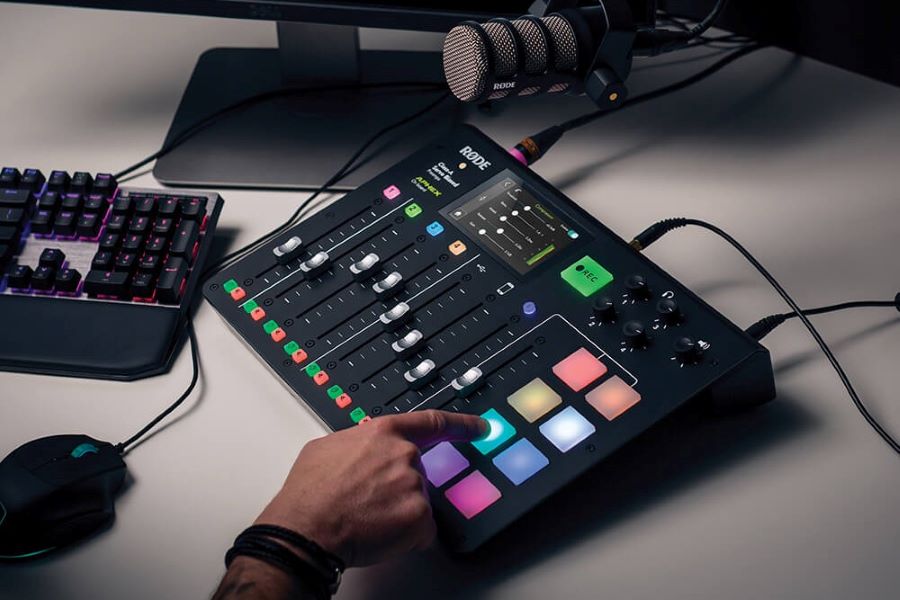The podcast microphone industry is booming, with many different manufacturers introducing versions of their own. With so much competition, the true winner is the consumer, who has multiple quality options to choose from.
One of the best microphones on the market is the RODE PodMic, an XLR microphone accompanied by RODECaster Pro Podcast Production Studio. This system ensures every audio recording is clear, greatly limiting any annoying background noises. Check out our top picks for the RODE PodMic Audio Interface.
Related: Top 9 Best Podcast Mixers | The Ultimate Buying Guide
Contents
Best RODE PodMic Audio Interface
When using the Rode PodMic you want to find the best audio interface that fits your needs. There are several to choose from depending on your budget and recording necessities.
Behringer ZB791 UMC22 Audiophile 2×2 USB Audio Interface
Compact and powerful, the Behringer ZB791 UMC22 Audiophile 2×2 USB Audio Interface is excellent for those seeking portability without compromising power and clarity.
Focusrite Scarlett Solo 3rd Gen Audio Interface
Say goodbye to distortion and muffled sounds with the Focusrite Scarlett Solo 3rd Gen Audio Interface. You will get professional-sounding recordings through two balanced outputs without breaking the bank! This is also one of the best audio interface for Shure SM7B.
Behringer U-PHORIA UM2
The Behringer U-PHORIA UM2 is your new go-to when you want quality without the fuss. You can get high-quality recordings every time with two inputs and outputs and a 48kHz resolution.
RODECaster Pro Podcast Production Studio

You can record direct to a pad from any of the RØDECaster Pro’s inputs or simply assign audio from your computer. Image Source.
One of the greatest selling points of the RODE PodMic is its optimization with the RODECaster Pro Podcast Production Studio. The RODECaster Pro Podcast Production Studio system ensures clear and crips recordings devoid of annoying background noises. The best part? The system doesn’t require you to do anything since the RODECaster and PodMic work together to adjust their settings to your voice automatically. That means no complicated setup process or confusing switches to worry about; you can start recording high-quality audio immediately!
It is possible to use the PodMic without the RODECaster Pro Podcaster Production Studio, but you will need to use your own audio interface system of choice. Additional audio interfaces and the necessary XLR cable are not included when purchasing your RODE PodMic.
Related: Rodecaster Pro Companion App: The Perfect Addition to Your Podcasting Studio
Related Questions
Does The RODECaster Pro Podcaster Production Studio Replace An Audio Interface?
Yes, you can use the RODECaster pro in place of a different audio interface system. This system allows you to streamline your recording sessions, making it faster and easier than ever to produce quality, broadcast-ready recordings.
Is The RODE PodMic Expensive?
No, the RODE PodMic is fairly priced at around $99 US.
Does The Rode PodMic Need An Interface?
The Rode PodMic is an incredibly dynamic microphone with built-in XLR connectivity, shock mount, and built-in pop filter, which makes it excellent at drowning out background and environmental noises. However, for additional gain, it does require an interface.
Do You Need A Mixer For Rode PodMic?
An audio mixer is recommended with Rode PodMic for those wishing to connect it to their computer.
Do You Need a Cloudlifter For Rode PodMic?
The vast majority of people will not need a Cloudlifter for their Rode PodMic, even if their voice is relatively quiet. However, if you find you are constantly setting your Rodecaster level higher than forty, a Cloudlifter would be highly beneficial.
How Can I Make My Rode PodMic Sound Better?
If you’re trying to make your Rode PodMic sound better and don’t have access to a mixer or the Rode Podcaster Pro, there are a few tricks you can use to make your PodMic sound better.
- Avoid boosting frequencies, instead reducing them in small amounts.
- Prioritize mic placement and technique. To reduce colored sound, place the microphone is no more than four handspans away, speak gently, and ensure your movements are controlled.
- For more colored sound, place the mic farther away and avoid sitting near perpendicular walls and low ceilings.
- Try to keep your clean recordings of every track. You can duplicate it and adjust the audio from there.
- Familiarize yourself with the spectrum analyzer in the DAW and keep a close eye on the frequency chart.
- Consider starting your mic frequencies under 80Hz using a high-pass filter and using a similar frequency reduction of 16kHz depending on the environment.
Related: How Much Gain Does RØDE PodMic Need? and Do I Need a Pop Filter for the Rode PodMic?
Summary
When you’re searching for a podcasting microphone that seamlessly integrates a high-quality audio interface system, look no farther than the RODE PodMic. Complete with a durable design that’s optimized to produce exceptional broadcast-ready recordings and the RODECaster Pro Podcaster Production Studio, which works as an integrated audio interface, the RODE PodMic has everything you need to create incredible audio recordings.
Related: Audio Interface vs. Mixer: Which is Better for Podcasting?